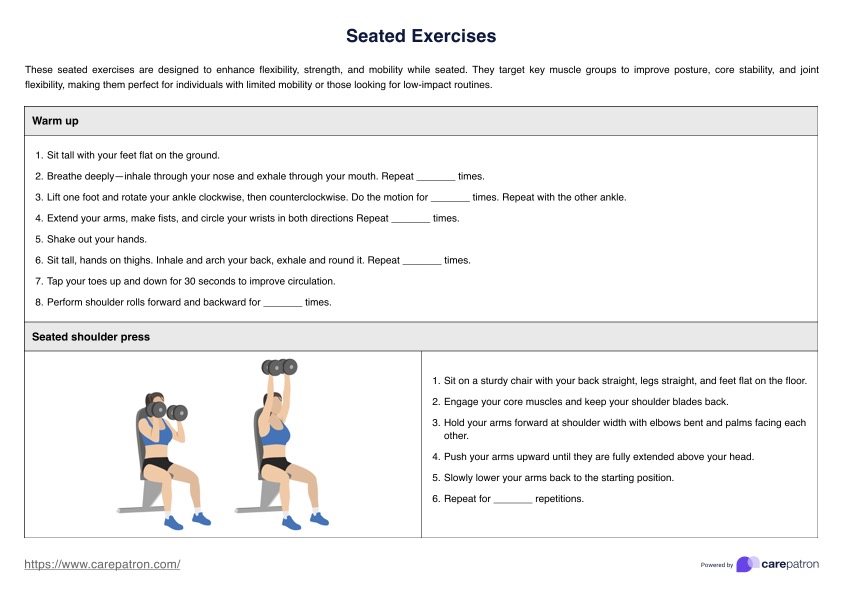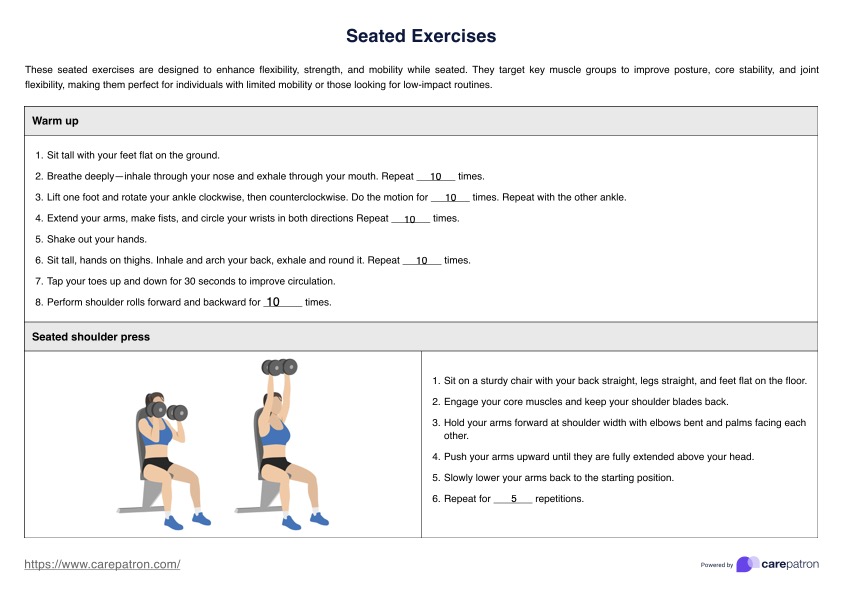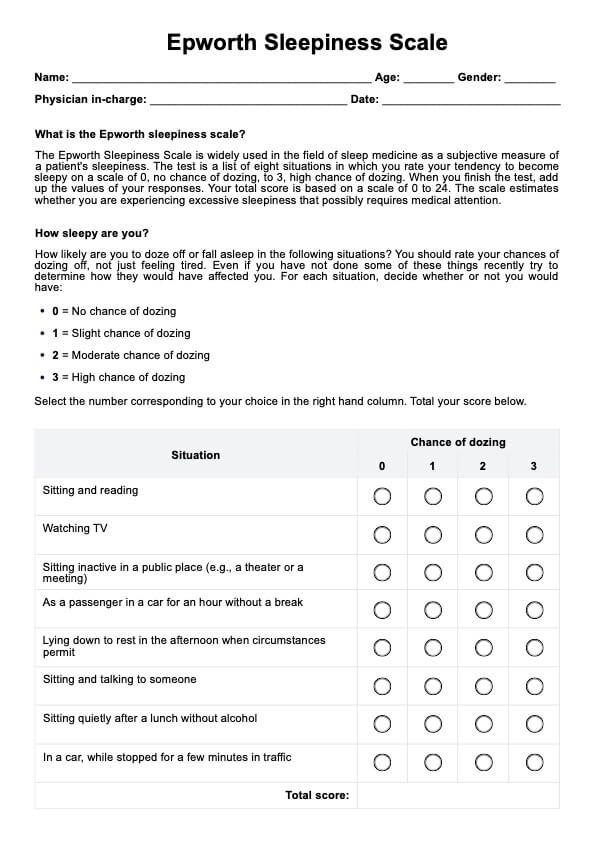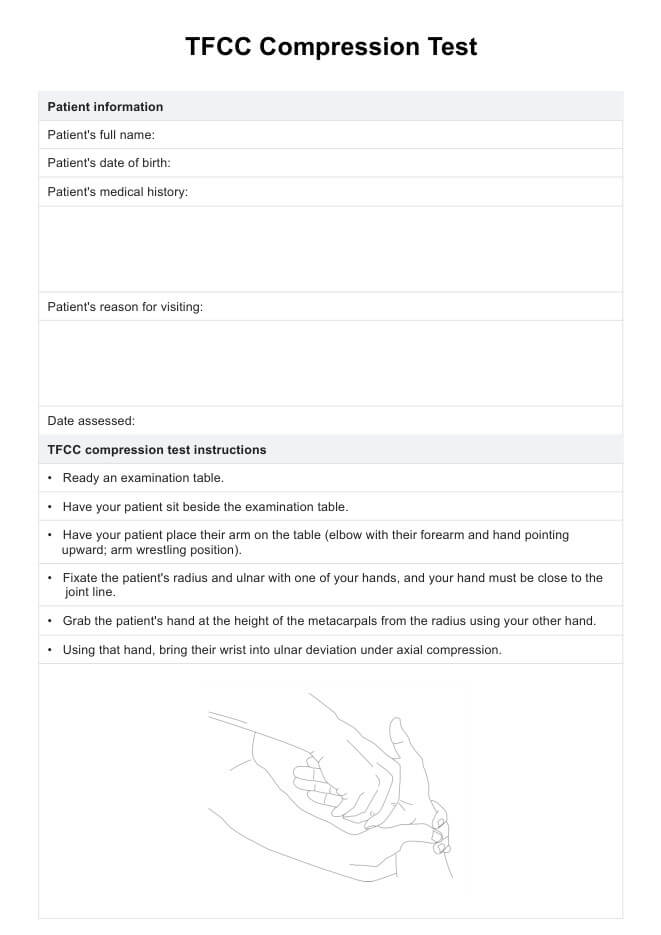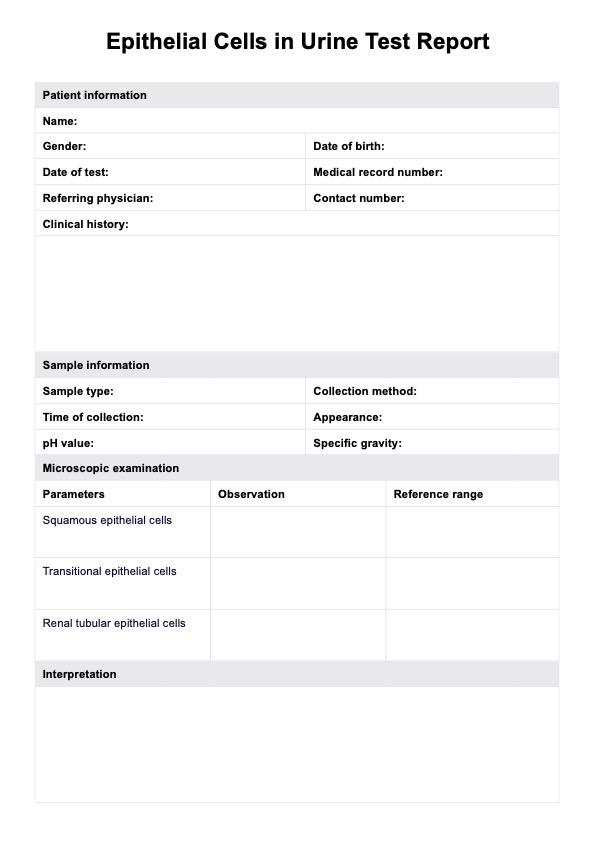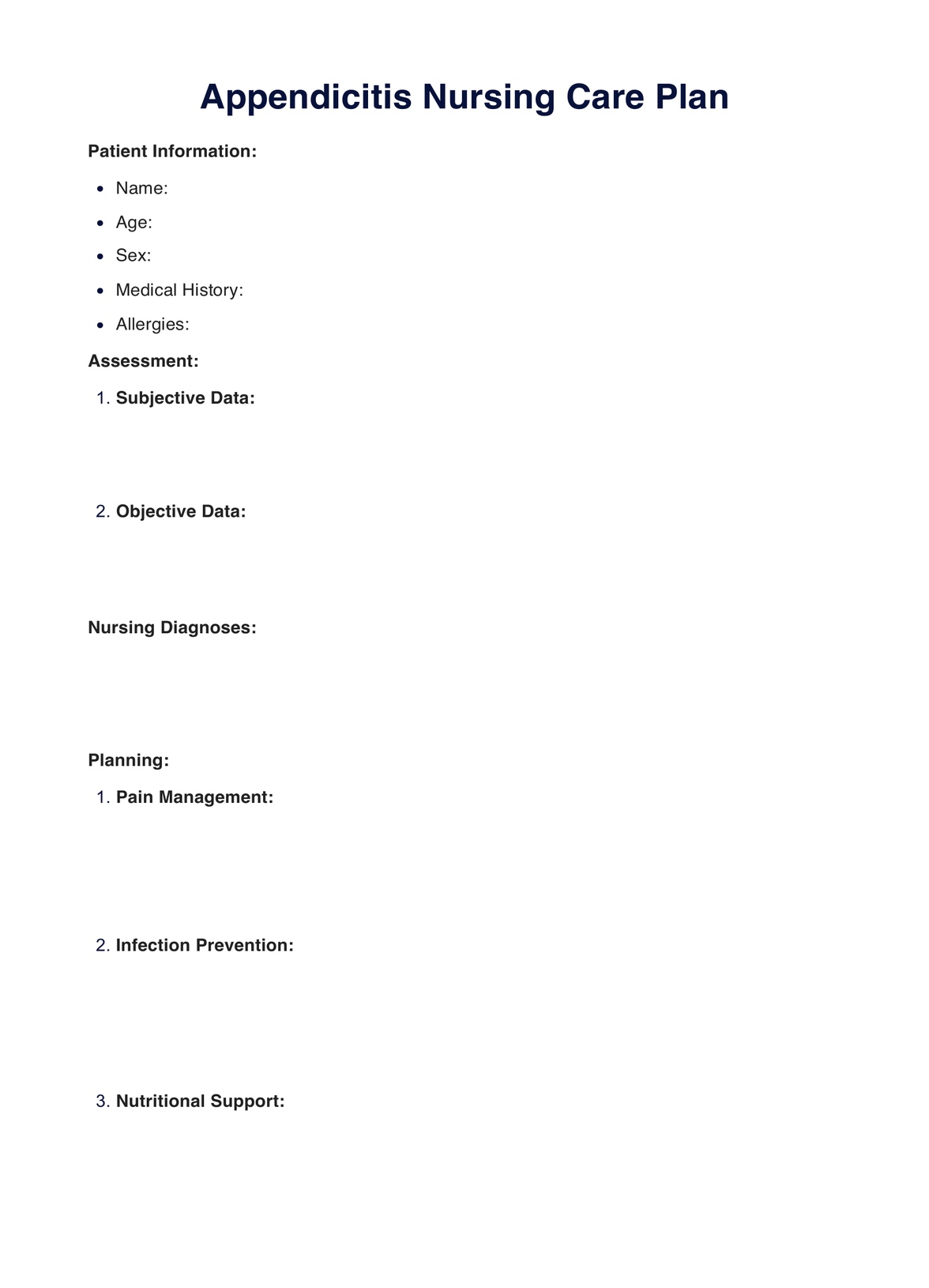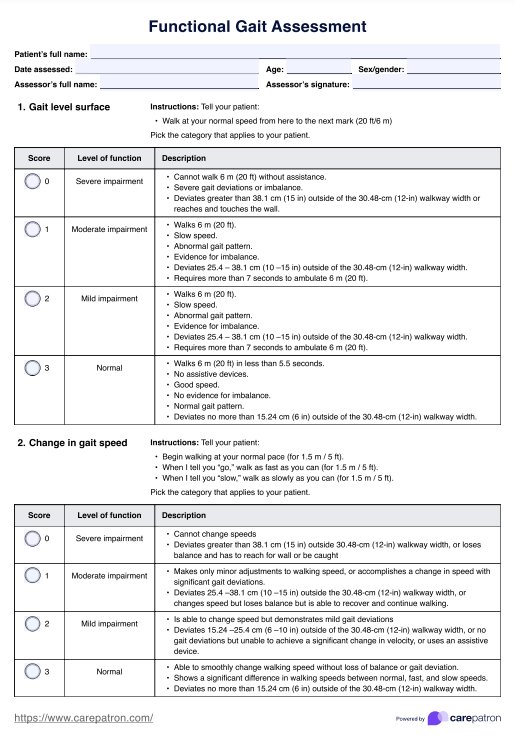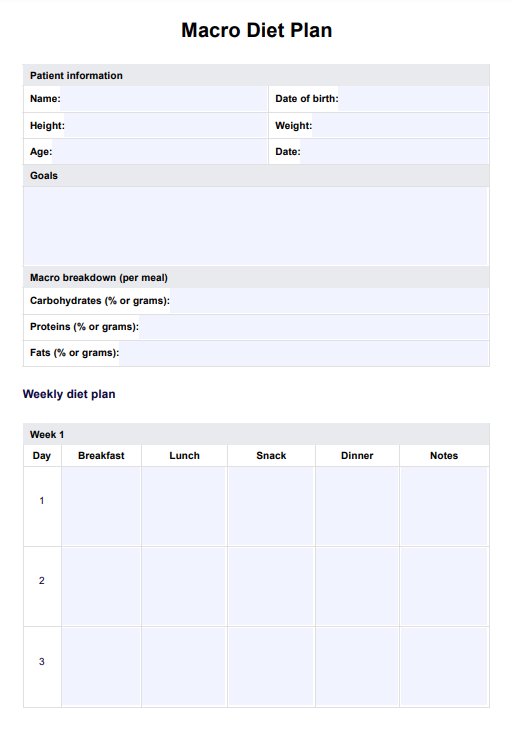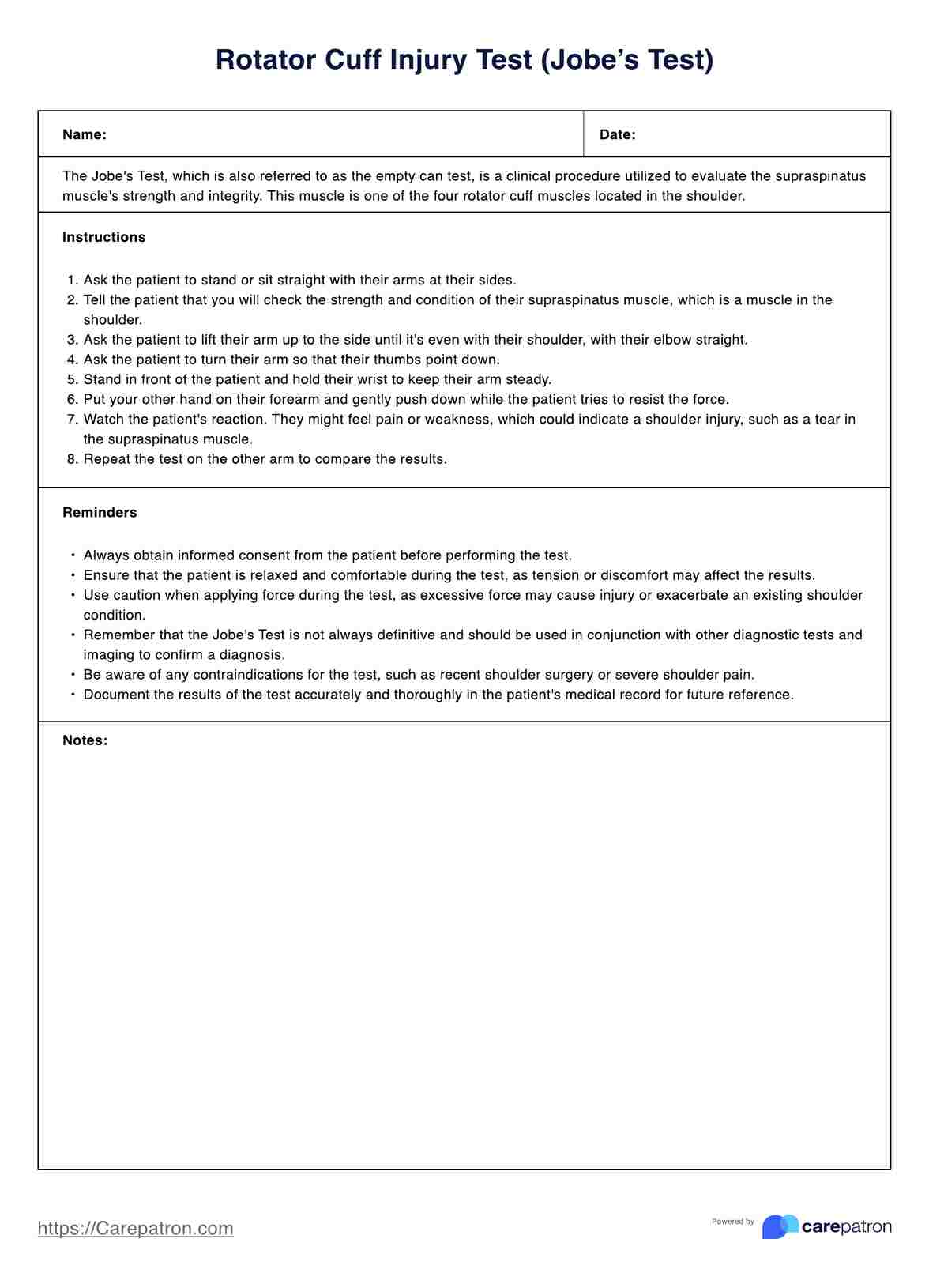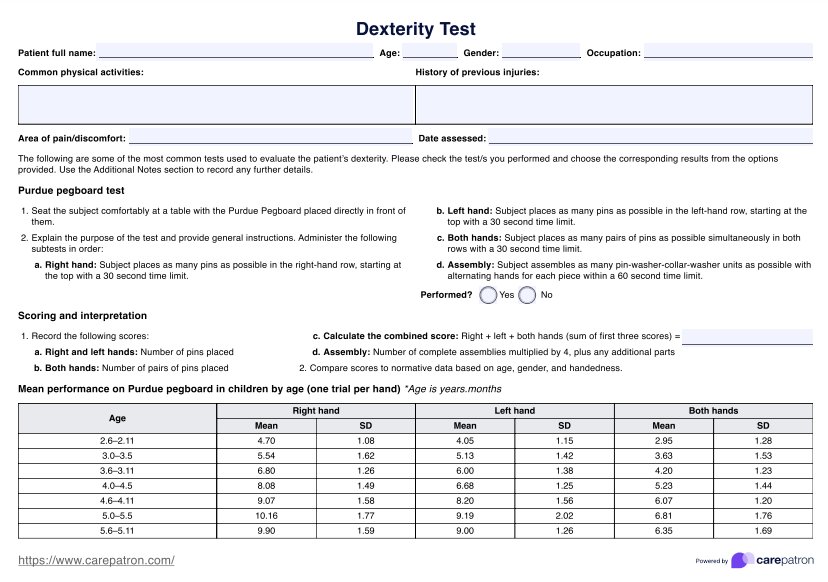Seated Exercises PDF
Learn various seated exercises for seniors and individuals with limited mobility. Download our free Seated Exercises PDF to your patients improve their overall wellness.


What are seated exercises for seniors?
Seated exercises offer a practical and effective way to engage in physical activity for individuals with limited mobility or those needing a low-impact workout. Seated exercises for seniors are carefully designed to improve strength, flexibility, and balance while minimizing strain on the body. They are particularly valuable for patients recovering from injuries, surgeries, or illnesses, providing a safe and controlled method to maintain or enhance physical fitness during rehabilitation.
Research supports the benefits of chair-based exercises, particularly in older adults. It shows improvements in balance, gait speed, grip strength, and other physical function metrics (Klempel et al., 2021). These exercises are highly versatile and can be adapted to meet individual needs, making them suitable for various settings, including clinics, homes, and community centers.
Moreover, sitting exercises can be effectively integrated into your patients' treatment plans to enhance mobility, prevent deconditioning, and facilitate rehabilitation. These exercises can be tailored to each patient's individual needs and abilities. By providing clear guidance on proper technique and adjusting the intensity of exercises as appropriate, you can ensure patients achieve optimal outcomes while minimizing the risk of injury.
Seated Exercises PDF Template
Seated Exercises PDF Example
Examples of seated exercises
Here are several examples of seated exercises that can be performed in a chair for seniors or individuals with limited mobility. The following steps provide clear instructions to help you demonstrate the exercises to your patients:
Seated shoulder press
Sit on a sturdy chair with your feet hip-width apart and flat on the floor. Engage your core and keep your back straight with your shoulder blades pulled back. Start with your arms bent, elbows at shoulder height, and palms facing each other. Push your arms straight up, fully extending them. Slowly lower to the starting position. Repeat for 10 repetitions.
Arm prayer stretch
Sit upright with your feet hip-width apart and flat on the floor. Bring your palms together in front of your chest with elbows bent and pointing out. Press your palms together gently while keeping your back straight. Hold for 15 seconds. Return to the starting position and repeat for eight repetitions.
Leg extensions
Sit upright with your feet hip-width apart and flat on the floor. Extend your left leg straight until it is parallel to the ground, keeping your toes pointing upward. Hold the position for 5 seconds, then slowly lower your leg. Alternate with the right leg, repeating for 12 repetitions per leg.
Seated marches
Sit with your back straight, feet hip-width apart, and firmly planted on the floor. Lift your left foot, bending the knee as if marching. Lower it back to the floor and repeat with your right foot. Continue alternating for 10 repetitions per leg.
Knee raises
Sit upright on a sturdy chair with your feet hip-width apart and hands on the chair legs for support. Slowly raise one knee bent toward your chest while engaging your core. Hold for 3 seconds, then lower the knee back to the floor. Alternate sides for 10 repetitions per leg.
Seated side bend
Sit on a sturdy chair with your feet flat and hip-width apart. Rest your right hand on the chair leg for support. Extend your left arm overhead and gently bend your torso to the right. Hold the stretch for 10 seconds, then return to the starting position. Repeat on the opposite side for a total of 8 repetitions per side.
Spinal twist
Sit upright with your feet hip-width apart and flat on the floor. Place your right hand on the outside of your left thigh and your left hand on the back of the chair for support. Slowly twist your torso to the left, looking over your shoulder. Hold for 15 seconds. Return to the starting position and repeat on the opposite side for six repetitions per side.
Glute rotation
Sit on a sturdy chair with your feet hip-width apart. Cross your right ankle over your left knee, forming a figure-four position. Press down on your right knee with your right hand while keeping your back straight. Hold the position for 10 seconds. Return to the starting position and repeat on the other side. Alternate for eight repetitions per side.
How does our Seated Exercises PDF work?
Our Seated Exercises PDF is designed to provide a variety of exercises that can be done while seated, making it accessible and beneficial for individuals with limited mobility. Follow these steps to get started:
Step 1: Access the template
Get a copy of the Seated Exercises PDF by clicking the "Use template" button, allowing you to access the handout via the Carepatron app. For a print-ready version, click "Download."
Step 2: Print or use the digital format
Give your patient the option to use either the printed or digital format, whichever is more convenient. If using the digital format, they can view it on their device and follow along.
Step 3: Start with a warm-up
It's important to always start with a warm-up before beginning any exercise routine. This helps prepare the body and reduces the risk of injury. The Seated Exercises PDF includes a warm-up section with gentle stretches to get the body moving.
Step 4: Choose exercises based on ability
Encourage your patient to start with exercises suitable for their current level of mobility and gradually work up to more challenging ones. The Seated Exercises PDF provides a range of options that can be modified depending on individual abilities.
Step 5: Focus on proper form and breathing
Remind your patient to pay attention to their posture and form while doing the exercises. It's essential to maintain good alignment to avoid strain or injury. Also, encourage them to take deep breaths throughout the routine for added relaxation and stress relief.
Step 6: Cool down with stretches
After completing the exercises, ensure your patient takes the time to cool down and stretch their muscles. This helps prevent lightheadedness or muscle soreness.
Step 7: Modify as needed
Everyone is different, so modify the exercises according to your patient's needs and abilities. Encourage them to listen to their body and take breaks when necessary.
Benefits of seated exercises
Seated exercises have numerous benefits, including:
- Improved strength and muscle tone: Seated exercises can help improve muscle strength and tone, especially in the core, arms, and legs. They use body weight as resistance to build muscles.
- Increased flexibility: Regular seated exercises can improve joint flexibility and range of motion. This is particularly beneficial for older adults or those with chronic conditions that affect mobility.
- Enhanced balance and coordination: Seated exercises can help improve balance and coordination, reducing the risk of falls and injuries.
- Low impact: These types of exercises are low impact, meaning they put less strain on joints and muscles than other forms of physical activity. This makes it ideal for those with joint pain or arthritis.
- Stress reduction: Seated exercises can also positively impact mental health. Focusing on movement and breath can help reduce stress and anxiety, promoting a sense of calmness and well-being.
When should you recommend seated exercises?
These exercises are suitable for various patients and situations, such as the following:
For patients with limited mobility
Seated exercises are ideal for patients with limited mobility due to age, injury, or chronic conditions. They provide a way to stay active and maintain muscle strength without putting too much strain on the body.
For post-surgery recovery
Seated exercises are an excellent option for patients recovering from surgery with limited mobility during their healing process. These exercises can help maintain muscle function and prevent stiffness.
When standing exercises are not an option
In some cases, patients may have conditions that make it difficult or unsafe to do standing exercises. Seated exercises provide a way to stay active without putting stress on the body.
During long periods of sitting
For patients who spend a lot of time sitting, whether at work or during travel, incorporating some seated exercises into their routine can help prevent stiffness and improve blood circulation.
For mental well-being
Physical activity has been linked to improved mental health. Seated exercises provide a low-impact form of movement that can contribute to overall well-being and reduce stress and anxiety.
For increasing physical activity
For patients who lead sedentary lifestyles, starting with seated exercises can significantly increase physical activity levels and improve overall health gradually. These exercises are a manageable and low-impact option for those who may not have the stamina or mobility for more intense activities.
Tips for patients doing chair workouts
Educating your patients on proper form and safety precautions when doing seated exercises is essential. Some tips to keep in mind include:
- Ensure the chair is sturdy and stable before beginning chair workouts to prevent falls or injuries.
- Advise your patients to start each seated exercise by sitting upright with feet shoulder-width apart to maintain balance and promote proper posture.
- Recommend controlling movements during chair exercises; for example, slowly bend the left knee, then carefully extend it back to the starting position.
- Include a variety of arm exercises in the exercise program, which can be done using light weights or resistance bands to increase upper body strength without adding too much strain.
- Emphasize the importance of gently returning to the starting position after each repetition to prevent muscle strain and ensure the full benefit of the seated exercise.
Reference
Klempel, N., Blackburn, N. E., McMullan, I. L., Wilson, J. J., Smith, L., Cunningham, C., O’Sullivan, R., Caserotti, P., & Tully, M. A. (2021). The effect of chair-based exercise on physical function in older adults: A systematic review and meta-analysis. International Journal of Environmental Research and Public Health, 18(4), 1902. https://doi.org/10.3390/ijerph18041902
Commonly asked questions
The best seated exercise depends on the person's goals. For strength, seated shoulder presses are excellent for building upper body muscles. For flexibility and mobility, spinal twists and cat-cow stretches are highly effective, improving posture and reducing stiffness.
Yes, seated exercises can be highly effective when performed consistently and with proper form. They target various muscle groups, improve flexibility, and enhance circulation. They’re particularly beneficial for individuals with mobility limitations or those seeking low-impact workouts.
Seated workouts can contribute to weight loss combined with a balanced diet and active lifestyle. They help burn calories, build muscle, and boost metabolism. While they may not be as calorie-intensive as high-impact exercises, they’re a great starting point for increasing physical activity.


